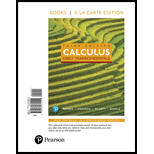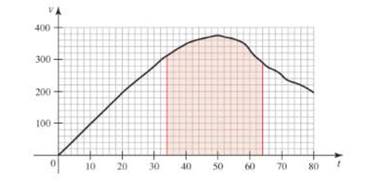
Free fall Use geometry and the figure given in Exercise 35 to estimate how far Felix fell in the first 20 seconds of his free fall.
Free fall On October 14, 2012, Felix Baumgartner stepped off a balloor capsule at an attitude of a most 39 km above Earth’s surface and began his free fall. His velocity in m/s during the fall is given in the figure. It is claimed that Felix reached the speed of sound 34 seconds into his fall and that he continued to fall at supersonic speed for 30 seconds. (Source: http://www.redbullstratos.com)
a. Divide the interval [34, 64] into n – 5 subintervals with the gridpoints x0 – 34, x1 – 40, x2 – 46, x3 – 52, x4 – 58, and x3 = 64. Use left and right Riemann sums to estimate how far Felix fall while travelling at supersonic speed.
b. It is claimed that the actual distance that Felix fell at supersonic speed was approximately 10.495 m. Which estimate in part (a) produced the more accurate estimate?
c. How could you obtain more accurate estimates of the total distance fallen than those found in part(a)?

Want to see the full answer?
Check out a sample textbook solution
Chapter 5 Solutions
Calculus: Early Transcendentals, Books A La Carte Edition (3rd Edition)
Additional Math Textbook Solutions
Basic Business Statistics, Student Value Edition
A Problem Solving Approach To Mathematics For Elementary School Teachers (13th Edition)
Elementary Statistics
Pre-Algebra Student Edition
A First Course in Probability (10th Edition)
Elementary Statistics: Picturing the World (7th Edition)
- Please help on both Part b) and c) below Thanksarrow_forwardfind the zeros of the function algebraically: f(x) = 9x2 - 3x - 2arrow_forwardRylee's car is stuck in the mud. Roman and Shanice come along in a truck to help pull her out. They attach one end of a tow strap to the front of the car and the other end to the truck's trailer hitch, and the truck starts to pull. Meanwhile, Roman and Shanice get behind the car and push. The truck generates a horizontal force of 377 lb on the car. Roman and Shanice are pushing at a slight upward angle and generate a force of 119 lb on the car. These forces can be represented by vectors, as shown in the figure below. The angle between these vectors is 20.2°. Find the resultant force (the vector sum), then give its magnitude and its direction angle from the positive x-axis. 119 lb 20.2° 377 lbarrow_forward
- An airplane flies due west at an airspeed of 428 mph. The wind blows in the direction of 41° south of west at 50 mph. What is the ground speed of the airplane? What is the bearing of the airplane?arrow_forwardA vector with magnitude 5 points in a direction 190 degrees counterclockwise from the positive x axis. Write the vector in component form, and show your answers accurate to 3 decimal places.arrow_forward||A||=23 45° Find the EXACT components of the vector above using the angle shown.arrow_forward
- Given ƒ = (10, -10) and q = (-8, −7), find ||ƒ— q|| and dƒ-9. Give EXACT answers. You do NOT have to simplify your radicals!arrow_forwardFind a vector (u) with magnitude 7 in the direction of v = (2,4) Give EXACT answer. You do NOT have to simplify your radicals!arrow_forwardGiven g = (-5, 10) and u = (5, 2), find -4ğ - 6.arrow_forward
- Algebra & Trigonometry with Analytic GeometryAlgebraISBN:9781133382119Author:SwokowskiPublisher:Cengage
 Trigonometry (MindTap Course List)TrigonometryISBN:9781305652224Author:Charles P. McKeague, Mark D. TurnerPublisher:Cengage Learning
Trigonometry (MindTap Course List)TrigonometryISBN:9781305652224Author:Charles P. McKeague, Mark D. TurnerPublisher:Cengage Learning Trigonometry (MindTap Course List)TrigonometryISBN:9781337278461Author:Ron LarsonPublisher:Cengage Learning
Trigonometry (MindTap Course List)TrigonometryISBN:9781337278461Author:Ron LarsonPublisher:Cengage Learning  Algebra and Trigonometry (MindTap Course List)AlgebraISBN:9781305071742Author:James Stewart, Lothar Redlin, Saleem WatsonPublisher:Cengage Learning
Algebra and Trigonometry (MindTap Course List)AlgebraISBN:9781305071742Author:James Stewart, Lothar Redlin, Saleem WatsonPublisher:Cengage Learning



